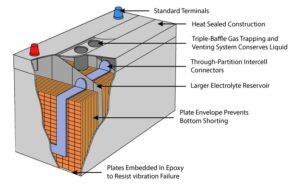Looking to charge your car battery but unsure about how many amps to use? You’ve come to the right place! In this article, we will provide you with a straightforward answer to the question, “How many amps to charge car battery?” Along the way, we’ll offer practical tips and insights to guide you through the process. So, let’s dive in and learn the optimal amperage for charging your car battery, ensuring a smooth and efficient experience. Whether you’re a car enthusiast or simply want to keep your vehicle running smoothly, understanding the right amperage is essential. Let’s explore this topic further.
How Many Amps to Charge a Car Battery: A Comprehensive Guide
Introduction:
Charging a car battery is an essential task that every vehicle owner should be familiar with. However, determining the appropriate amperage for charging your car battery can be a bit confusing. In this comprehensive guide, we will delve into the details of how many amps you need to charge a car battery effectively. Whether you are a beginner or an experienced driver, this article will provide you with the necessary knowledge to keep your car battery in optimal condition.
The Importance of Charging your Car Battery Correctly
Before we dive into the specifics, it’s crucial to understand why it is essential to charge your car battery correctly. Charging your car battery properly not only extends its lifespan but also ensures that it will function reliably when you need it the most. An undercharged or overcharged battery can lead to performance issues, reduced capacity, and even permanent damage. Therefore, knowing the right amount of amps to charge your car battery is crucial for its longevity and performance.
Understanding Amps and Battery Basics
Before we discuss the appropriate amperage for charging a car battery, let’s briefly go over some battery basics. A car battery is a rechargeable device that stores electrical energy. It consists of several cells, each producing around 2.1 volts of electrical potential. These cells are connected in series, typically resulting in a 12-volt battery in most vehicles.
Amperage, often abbreviated as amps, refers to the rate at which electrical current flows through a circuit. In the case of a car battery, it represents the rate at which the battery charges or discharges. When charging a battery, the amps indicate how quickly the battery will recharge.
Factors to Consider when Choosing the Right Amperage
Several factors come into play when determining the appropriate amperage for charging a car battery. Let’s explore these factors to help you make an informed decision:
1. Battery Capacity
The capacity of a car battery is measured in ampere-hours (Ah) and indicates the amount of charge it can store. The higher the battery capacity, the longer it will take to charge. It’s important to consider the battery capacity when selecting the appropriate amperage.
2. Charger Output
Different chargers have varying output capabilities, which are typically measured in amps. It’s crucial to use a charger that matches or slightly exceeds your battery’s recommended charging amperage. Using a charger with too low an output may prolong the charging time, while a charger with too high an output can damage the battery.
3. Charging Time
Consider the time you have available to charge your car battery. If you need a quick boost before hitting the road, a higher amperage may be suitable. However, if time is not a constraint, a lower amperage can be used for a more gradual and gentle charge.
4. Battery Condition
The condition of your car battery also plays a role in determining the appropriate amperage. Older or deeply discharged batteries may require a lower initial charging amperage to prevent damage. It is advisable to assess the battery’s condition and adjust the charging amperage accordingly.
5. Environmental Factors
Environmental conditions, such as temperature, can affect the charging process. In colder climates, batteries may require a slightly higher charging amperage to compensate for reduced chemical reactions. Conversely, in hotter climates, a lower charging amperage can prevent overcharging.
Determining the Appropriate Charging Amperage
Now that we have discussed the factors to consider let’s delve into determining the appropriate charging amperage for your car battery.
1. General Guidelines
As a general guideline, most experts recommend charging a car battery at a rate of 10-20% of its ampere-hour (Ah) rating. For example, if your battery has a 50Ah rating, a charging rate of 5-10 amps would be appropriate.
2. Maintenance Charging
For routine maintenance charging, such as topping up a partially discharged battery, a lower charging amperage is recommended. A rate of 2-4 amps is typically sufficient to bring the battery back to a fully charged state. This low and steady charging rate helps prevent overcharging and extends the battery’s lifespan.
3. Fast Charging
If you are looking for a quick charge to get your vehicle back on the road, a higher amperage can be used. Fast charging rates typically range from 15-30 amps, allowing for a more rapid recharge. However, it’s important to note that fast charging for extended periods can generate excess heat and potentially damage the battery.
4. Trickle Charging
Trickle charging is a low-amperage charging method used to maintain a fully charged battery over an extended period. This slow and continuous charge, typically around 1-2 amps, compensates for self-discharge and ensures that the battery remains ready for use.
Determining the appropriate amperage for charging a car battery is essential for maintaining its performance and longevity. By considering factors such as battery capacity, charger output, charging time, battery condition, and environmental factors, you can select the most suitable charging amperage. Remember to use general guidelines, consider maintenance charging, opt for fast charging when necessary, and utilize trickle charging for long-term battery maintenance. With the knowledge gained from this comprehensive guide, you can confidently charge your car battery and ensure its reliability for years to come.
Frequently Asked Questions
What is the recommended amperage to charge a car battery?
The recommended amperage to charge a car battery is typically between 4 to 8 amps. Charging within this range allows for a safe and efficient charging process without the risk of damaging the battery. Higher amperage charging, such as using a fast charger, may result in overheating and potential damage to the battery.
Can I use a higher amperage charger to charge my car battery faster?
While it may be tempting to use a higher amperage charger to speed up the charging process, it is not recommended. Using a charger with a significantly higher amperage than what is recommended can lead to overheating, overcharging, and potential damage to the battery. It is best to stick to the recommended amperage range to ensure safe and effective charging.
Can I use a lower amperage charger to charge my car battery?
Using a lower amperage charger to charge your car battery is possible, but it will result in a slower charging process. If you are using a lower amperage charger, it is important to monitor the charging progress and ensure that the battery is being charged adequately. It may take longer to reach a full charge, but it can still be a safe and effective method if done properly.
What are the risks of overcharging a car battery with too many amps?
Overcharging a car battery with too many amps can lead to overheating, which can cause damage to the battery. Continuous overcharging can also result in the battery electrolyte boiling, which can cause the battery to leak or even explode. It is essential to use the recommended amperage to avoid these risks and ensure the longevity of the battery.
Is it possible to charge a car battery with a lower amperage for an extended period of time?
Yes, it is possible to charge a car battery with a lower amperage for an extended period of time. However, it is important to monitor the charging progress and ensure that the battery is not being undercharged. Continuous undercharging can lead to sulfation, a condition that reduces the battery’s capacity and overall performance. If you choose to charge with a lower amperage, it is recommended to periodically check the battery’s voltage and charge level to ensure it is charging properly.
Final Thoughts
To determine how many amps are required to charge a car battery, it is essential to consider the battery’s capacity and the charging time available. The general rule of thumb is that a car battery should be charged at a rate of 10-20% of its capacity in amps. For instance, a 50 amp-hour battery should be charged with a 5-10 amp charger over the course of at least 5 hours. However, it is crucial to consult the car’s manual or a professional to ensure the correct charging specifications for your specific battery model. So, when it comes to how many amps to charge a car battery, always refer to the battery’s capacity and seek expert advice if needed.



